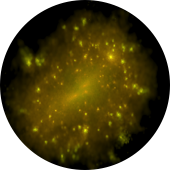DRAGONS
 The Dark-ages, Reionization And Galaxy-formation Observables Numerical Simulation project (DRAGONS) combines a semi-analytic model for galaxy formation designed to accurately represent the growth of galaxies, with a semi-numerical model for the growth and evolution of ionized structure. The goal of DRAGONS is self-consistent modelling of observations of high redshift galaxies and the structure and morphology of reionization.
The Dark-ages, Reionization And Galaxy-formation Observables Numerical Simulation project (DRAGONS) combines a semi-analytic model for galaxy formation designed to accurately represent the growth of galaxies, with a semi-numerical model for the growth and evolution of ionized structure. The goal of DRAGONS is self-consistent modelling of observations of high redshift galaxies and the structure and morphology of reionization.
Tiamat simulations
 The Tiamat simulations are a suite of large collisionless N-Body simulations upon which DRAGONS is built. The primary asset setting Tiamat apart from most other large simulation programs is its high density of simulation outputs at high redshift (100 from z=35 to z=5; roughly one every 10 Myrs) enabling the construction of very accurate merger trees at an epoch when galaxy formation is rapid and mergers extremely frequent. We use Tiamat to analyse the dynamical evolution of galaxies at high redshift, drawing comparisons to low-redshift results from other simulations.
The Tiamat simulations are a suite of large collisionless N-Body simulations upon which DRAGONS is built. The primary asset setting Tiamat apart from most other large simulation programs is its high density of simulation outputs at high redshift (100 from z=35 to z=5; roughly one every 10 Myrs) enabling the construction of very accurate merger trees at an epoch when galaxy formation is rapid and mergers extremely frequent. We use Tiamat to analyse the dynamical evolution of galaxies at high redshift, drawing comparisons to low-redshift results from other simulations.
Meraxes
 Meraxes is a brand new semi-analytic galaxy formation model, specially designed for studying galaxy formation during the Epoch of Reionisation. Meraxes includes a fully temporally and spatially coupled treatment of reionisation and is built upon the Tiamat N-body simulations which possesses both sufficient volume and mass resolution to study reionisation structure as well as the temporal resolution needed to resolve the galaxy and star formation physics relevant to early galaxy formation.
Meraxes is a brand new semi-analytic galaxy formation model, specially designed for studying galaxy formation during the Epoch of Reionisation. Meraxes includes a fully temporally and spatially coupled treatment of reionisation and is built upon the Tiamat N-body simulations which possesses both sufficient volume and mass resolution to study reionisation structure as well as the temporal resolution needed to resolve the galaxy and star formation physics relevant to early galaxy formation.
Meraxes Data products can be downloaded here
Smaug
 Smaug is a suite of gas hydrodynamic cosmological simulations of used to model galaxy formation at high redshift. The simulations include galaxy formation with strong, thermally coupled supernovae. These models produce enough UV photons to sustain reionization through a significant population of faint, unobserved, galaxies. This predicted population is consistent with extrapolation of the faint end of observed UV luminosity functions. We use these models to inform and calibrate the physics implementations in our Meraxes model
Smaug is a suite of gas hydrodynamic cosmological simulations of used to model galaxy formation at high redshift. The simulations include galaxy formation with strong, thermally coupled supernovae. These models produce enough UV photons to sustain reionization through a significant population of faint, unobserved, galaxies. This predicted population is consistent with extrapolation of the faint end of observed UV luminosity functions. We use these models to inform and calibrate the physics implementations in our Meraxes model